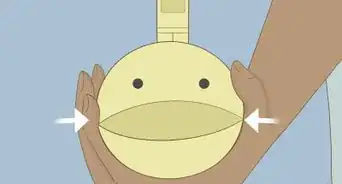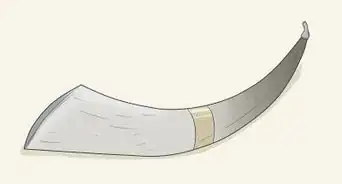This article was co-authored by wikiHow Staff. Our trained team of editors and researchers validate articles for accuracy and comprehensiveness. wikiHow's Content Management Team carefully monitors the work from our editorial staff to ensure that each article is backed by trusted research and meets our high quality standards.
There are 8 references cited in this article, which can be found at the bottom of the page.
wikiHow marks an article as reader-approved once it receives enough positive feedback. In this case, 80% of readers who voted found the article helpful, earning it our reader-approved status.
This article has been viewed 315,344 times.
Learn more...
The trombone is one of the deepest and most powerful symphonic instruments. Whether it's in the form of a symphony, marching band, brass ensemble, concert band, or jazz band, the trombone always is always heard and enjoyed. It's not an easy instrument to play, but with some practice and passion, you'll be on your way to being a formidable player!
Steps
Assembling the Trombone
-
1Attach the mouthpiece to its receiver. The mouthpiece receiver is connected to the top of the main slide—the tip of the U-shaped metal piece that runs parallel to the bell portion of the trombone. Place the mouthpiece into the receiver and make a twisting motion while applying light pressure. Just don't force or push the mouthpiece or it might get stuck![1]
- Never try to insert the mouthpiece in the receiver with the palm of your hands—this is guaranteed to jam it.
-
2Connect the 2 ends of the bell section to the 2 ends of the tuning slide. The back of the tuning slide is the smallest U-shaped portion of the trombone with one vertical bar running through it. Align its 2 screw-ends with the 2 exposed ends attached to the section of the trombone that contains that bell. Now, press these sections together.[2]
- Don't press too hard—a moderate amount of pressure is all you need to connect the bell section to the tuning slide.
Advertisement -
3Attach the bell section to the main slide. Hold the bell section to your left with the bell closest to you. In your right hand, hold the main slide—the piece with the mouthpiece attached—with the longer side facing you and the shorter side facing away from you. Place the slide section on the ground and attach the small end of the bell section—the part that's not the bell—onto the longer end of the mouthpiece slide, which should be closest to you. Twist the pieces together so that the main slide makes a right angle with the bell.[3]
- Take two fingers and place them on the edge of the bell—this is the distance that should be between the mouthpiece slide and the bell.
- Tighten the thumbscrew once you've aligned the mouthpiece slide properly.
Holding the Trombone
-
1Hold the trombone with your left hand by gripping the screw-joint. The screw-joint is located underneath the bell. Grip it firmly with your left hand—you’ll be able to support the trombone by using this hold. Now, make a gun with your left hand, extend your index finger so it touches the mouthpiece, and wrap your thumb around the bar closest to it.[4]
- Use your remaining 3 fingers to grip the vertical bar below your index finger.
- Make sure the slide is locked when you aren't playing the horn. If you leave it open, the slide can fall off and get damaged. The slide lock is typically located at the region where the main slide connects to the bell section.
-
2Grip the movable part of the slide gently with your right hand. Use the tips of your index and middle fingers and your thumb to grip the main slide. This is the hand you use to move the main slide forward and backward. Again, make sure the slide is locked—one small dent in the slide can cause it to become stuck and unmovable![5]
- Relax your right-hand grip and shoulders.
- Always maintain a firm grip on the trombone with your left hand, even as you relax your right hand.
-
3Keep your body centered when playing. This loosens up your chest and stomach, which allows your diaphragm to fill up with more air and helps you inhale faster. If you're sitting, sit as far back in the chair as possible and always keep your back against the back of the chair. Sitting on the edge of the seat restricts the air flow from your lungs.[6]
- Avoid sitting whenever possible.
- If you sit, place your feet firmly onto the ground while keeping your body centered.
Playing the Trombone
-
1Blow through the mouthpiece using an "o" shape with your lips. Hold the small mouthpiece to the middle of your lips. Now, press your lips firmly against it, inhale deeply, and blow out through it. Keep the corners of your lips tight and leave the center loose. Blow hard enough that you feel your lips vibrate and hear a blowing sound.[7]
- Make a small hole in the center of your lips as you blow air.
- Don't puff your cheeks out when playing—this will make you short of breath quickly, and your note will sound rough and spluttered.
-
2Play higher pitched "tee" notes by tightening your lips. High pitches are created by faster lip vibrations, which are created by tightening your lips as you blow. To tighten your lips, pull back the corners of your mouth to make them more firm as you play higher. Your jaw should raise naturally and the air you're blowing should move in a more downward motion. The final sound should be a "tee."[8]
- Make sure that you stay relaxed when playing higher notes and blow faster air through the instrument. Don't make any weird faces that would cause tension in the sound.
- It will feel natural to press against the mouthpiece for higher notes—resist this temptation, as it will lead to problems later.
-
3Play lower pitched "tay" notes by loosening your lips. Low pitched notes are created by slower lip vibrations, which are accomplished by loosening the center of your lips and dropping your jaw. However, the air still needs to remain fairly fast and steady. To maintain a good quality sound, you'll need to exhale more air than you do with higher pitched notes. Keep in mind that trombones—especially bass trombones or tenor trombones with trigger attachments—need a lot more air to play a well-supported note because of all the extra tubing.
- When you first start playing the lower register, it may be very challenging. To do well, increasing your lung capacity is the key.
-
4Blow harder and more "openly" to play louder. Drop your jaw and part your lips slightly to achieve a rounder, brassier sound. Always remember that playing "openly" does not mean loosening your lips.[9]
-
5Learn the first 3 positions on the slide. The first position is when the slide is almost all the way in. The second position is a little more than halfway between 1st and 3rd. Again, this position will vary, but the higher the note, the higher the slide tends to need to be. The third position is slightly after the bell, but will vary depending on the register in which the note is played.[10]
- Make sure you don't slam the slide in when returning to the first position.
-
6Practice the remaining four positions on the slide. The fourth position is located just past the bell, and the fifth position is located a little past the fourth position. The sixth position is almost all the way out—near the seventh position—and the seventh position is all the way out[11]
- On most trombones, there is a lip or marking where the seventh position is.
- The positions may vary slightly depending on the type of trombone you play.
Improving Your Skills
-
1Increase your range of notes by practicing regularly. Try to practice once a day for at least 30 minutes. Increase your lip flexibility by moving from one note to a higher one and back. Keep gradually going faster while maintaining an even sound.
- Conduct scale exercises regularly.
- Remember that trombone technique workbooks are available from most music stores. If you're serious about learning to play the trombone, check them out!
-
2Increase your lung capacity. Practice long notes to increase your lung capacity. Other ways to increase lung capacity are running, bicycling, and swimming. In general, any cardiovascular activity will benefit your playing.
- Practice some general breathing exercises.
-
3Find new pieces to play as often as you can. After you're comfortable playing all of the trombone pieces you know, find more! Listen to songs from Joe Alessi, Christian Lindberg, or Wycliffe Gordon and learn their discography. Search for trombone sheet music online and try to learn new pieces as often as you can.[12]
- Keep an ear out for songs with trombones and if you hear something you like, learn it!
- Download sheet music for free here: https://www.8notes.com/trombone/.
-
4Join the International Trombone Association (ITA) for regular events and lessons. After joining the ITA, you have access to a list of events and competitions for trombone players like yourself. Not only that, you gain access to their video section, which offers lessons, interviews, musical shorts, and more.[13]
- Choose the Student membership for the cheapest option. For more comprehensive packages, choose the Library, Donor, Patron, or Lifetime package.
- Visit the ITA website here: https://www.trombone.net/.
-
5Watch YouTube trombone lessons for convenient home learning. YouTube offers plenty of trombone lesson videos from experienced professionals. For example, Mr. Glynn offers seven lessons that cover everything from the first five notes to techniques like tonguing and sliding. The lessons are designed to provide classroom learning in a home environment. Most of the videos are under five minutes and are simple but effective.[14]
- Subscribe to channels that offer the trombone lessons that you find the most helpful.
Community Q&A
-
QuestionWhich way does a sharp go?
 Community AnswerA sharp goes higher in pitch. To play sharper, pull in slightly on the slide from the position the note you wish to play is in. Over time your emboucher will allow you to manipulate the pitch of a note without moving the slide.
Community AnswerA sharp goes higher in pitch. To play sharper, pull in slightly on the slide from the position the note you wish to play is in. Over time your emboucher will allow you to manipulate the pitch of a note without moving the slide. -
QuestionHow can I remember the notes?
 Community AnswerTry making a catchy song for the notes and positions. Also, you could practice the base notes for every position in your free time. Get a fingering chart to assist you.
Community AnswerTry making a catchy song for the notes and positions. Also, you could practice the base notes for every position in your free time. Get a fingering chart to assist you. -
QuestionI have a hard time getting the trombone to stay together because I can't get the thumbscrew to stay secured. What can I do?
 Community AnswerMake sure you're tying it tightly and if that doesn't work, take it to your teacher or to a nearby instrument shop.
Community AnswerMake sure you're tying it tightly and if that doesn't work, take it to your teacher or to a nearby instrument shop.
Warnings
- Do not jam the mouthpiece into your lips when playing. Over time, this can cause scarring, which will eventually diminish your performing abilities.⧼thumbs_response⧽
- Do not force yourself to go to a certain position or you will hurt your arms. Many beginner players—especially younger ones—cannot reach the 6th or 7th position. If you can't, that's okay.⧼thumbs_response⧽
- When laying down your horn, do not let it rest on the slide. Eventually, this will cause it to warp.⧼thumbs_response⧽
- Never use "Brasso" on a brass instrument. This removes the lacquer and allows the metal to erode. You can buy instrument lacquer from most music stores or brass instrument specialists.⧼thumbs_response⧽
- Always rinse out your mouth with water before playing to get rid of any food that might be in your mouth.⧼thumbs_response⧽
- Do not eat candy, gum, or any other kind of food while playing your trombone.⧼thumbs_response⧽
- While the F attachment is great for beginners, always use the trigger in moderation. The F attachment is useful for certain musical passages and alternate positions, but many students use the F attachment as a crutch. Some musicians use this attachment to allow for a key in lower register notes to be played in the 7th position.⧼thumbs_response⧽
Things You'll Need
- Trombone
- Study books (try "Arban's Famous Method for Trombone" or "Melodious Etudes for Trombone," which is 3 books in total)
References
- ↑ http://www.meyer-music.com/wp-content/uploads/2014/07/Trombone.pdf
- ↑ http://www.meyer-music.com/wp-content/uploads/2014/07/Trombone.pdf
- ↑ https://youtu.be/z-Yj_jLNKKg?t=136
- ↑ https://www.yamaha.com/en/musical_instrument_guide/trombone/play
- ↑ https://www.yamaha.com/en/musical_instrument_guide/trombone/play
- ↑ https://www.yamaha.com/en/musical_instrument_guide/trombone/play
- ↑ https://www.yamaha.com/en/musical_instrument_guide/trombone/play/
- ↑ https://www.yamaha.com/en/musical_instrument_guide/trombone/play/
- ↑ https://www.yamaha.com/en/musical_instrument_guide/trombone/play/
About This Article
If you want to learn to play the trombone, grip the joint underneath the bell with your left hand with your index finger resting on the mouthpiece. Use your right hand to hold the slide, but since you’ll be moving the slide, don’t support the weight of the trombone with that hand. Make an “o” shape with your lips and press them to the mouthpiece, then blow. Tighten your lips as you’re blowing to play higher notes, and relax them to play lower notes. At the same time, move the slide to different positions to play various notes. For more on how to use the slide, read on!
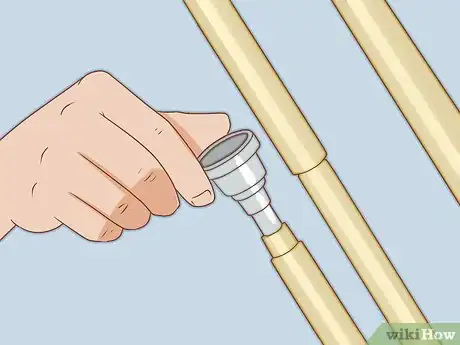
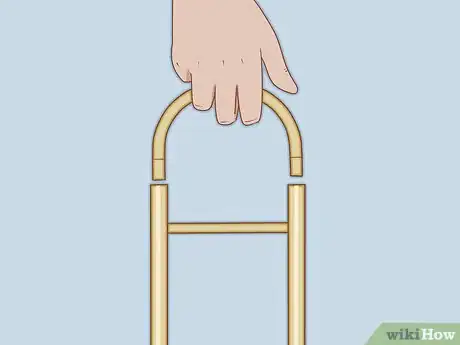
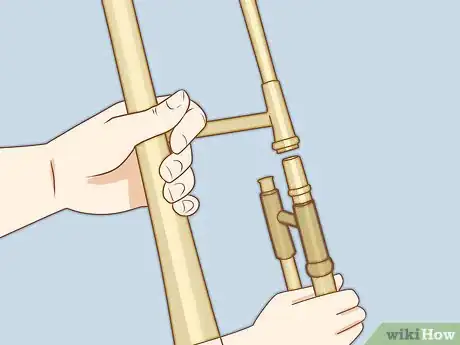

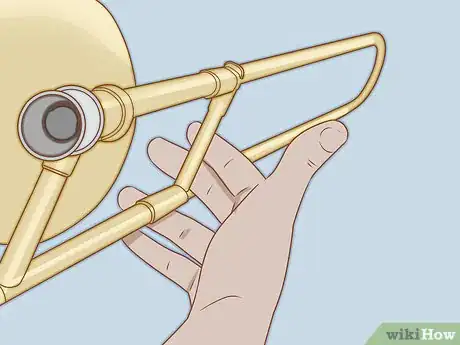
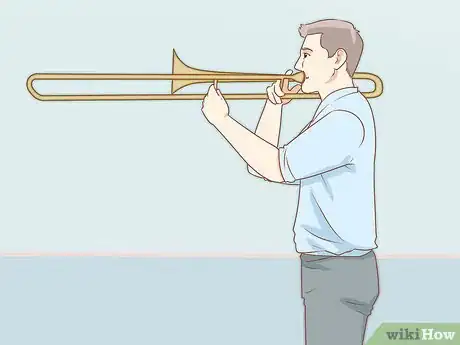
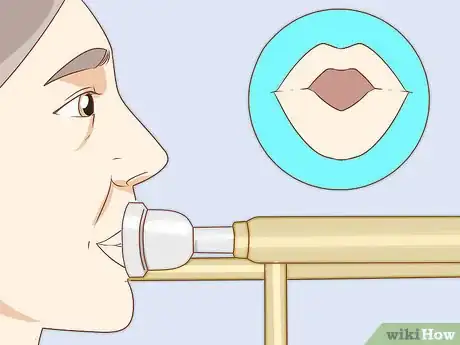
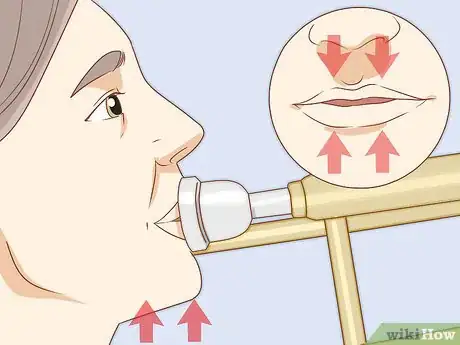
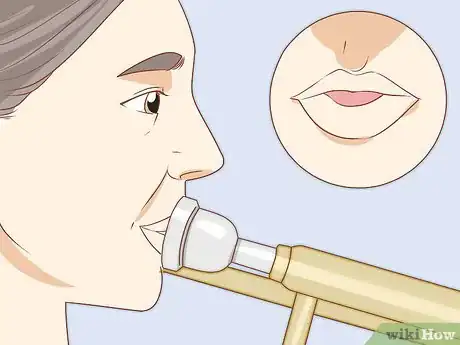
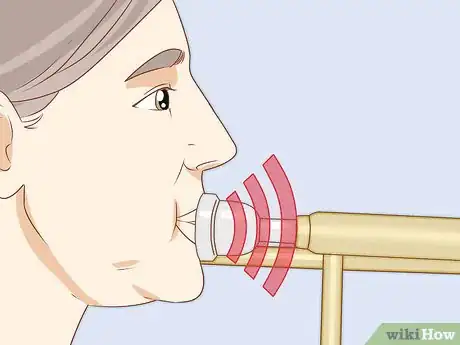
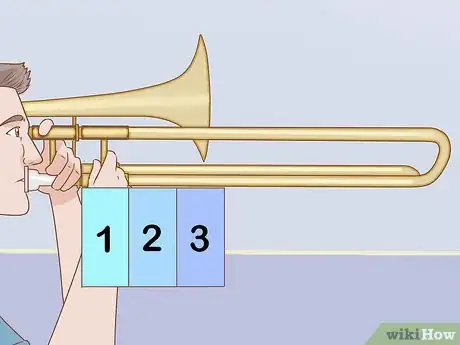
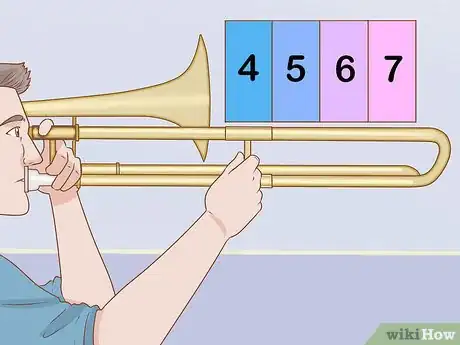


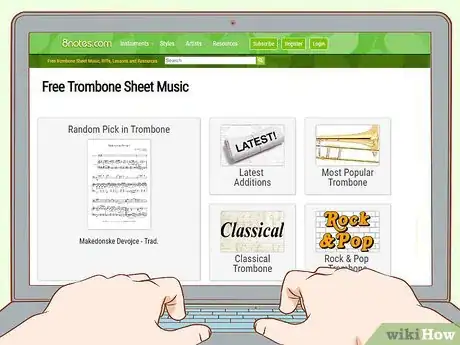
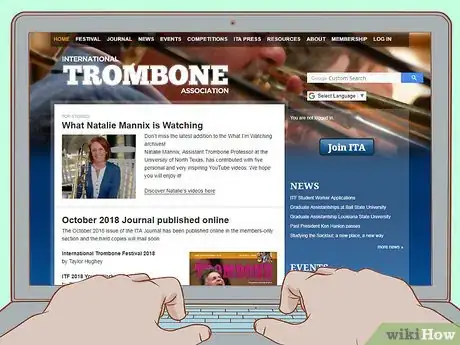
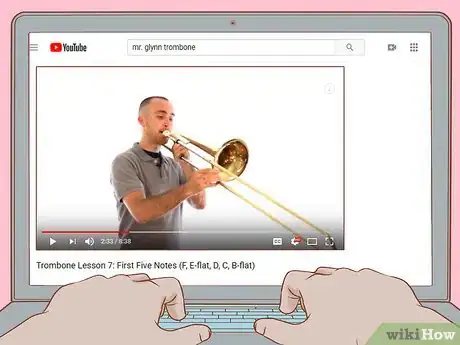









-Step-17-Version-4.webp)

